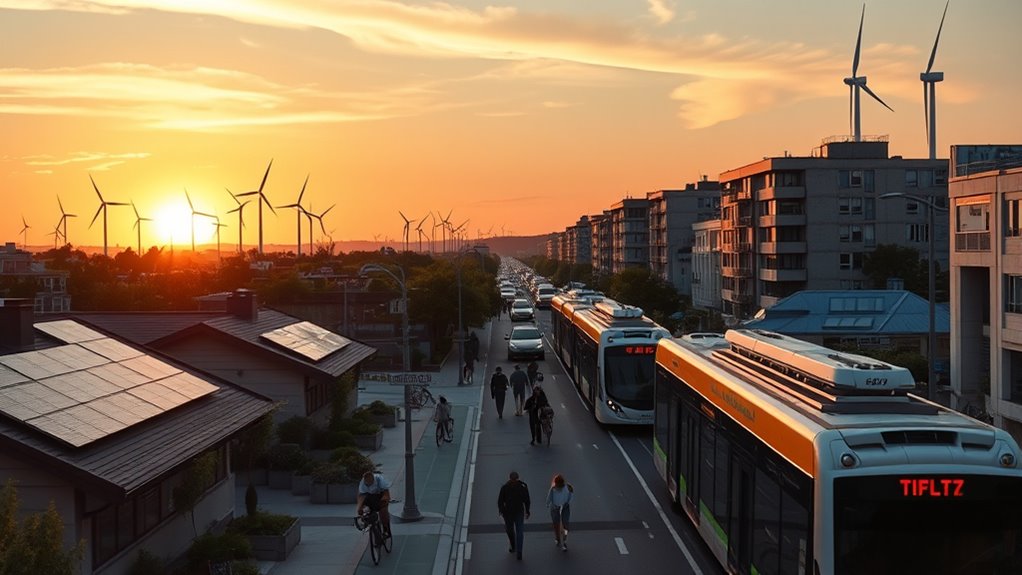Investing in a low-carbon future involves mobilizing a growing climate finance sector that exceeded $2 trillion in early 2024. While private sector investments now outpace public funds, a significant $4.4 trillion annual gap remains to meet climate goals. Overcoming access hurdles, fostering public-private partnerships, and leveraging innovative financial tools help bridge this divide. Continuing to explore these strategies can reveal how you can contribute to building sustainable, resilient economies worldwide.
Key Takeaways
- Climate finance has surpassed $1.9 trillion annually, with private sector investments leading, yet a $4.4 trillion annual gap remains.
- Public-private collaborations, policy incentives, and catalytic capital are essential to scale low-carbon investments.
- Mobilizing diverse funding sources and reducing access barriers in emerging markets accelerate climate project implementation.
- Investing in renewable energy, green infrastructure, and sustainable sectors creates economic, health, and employment benefits.
- Transparent monitoring and strengthened commitments are crucial to track progress and close the climate finance gap.
The Growing Scale of Global Climate Finance

The scale of global climate finance has expanded rapidly in recent years, reaching a record $1.9 trillion in 2023 and exceeding $2 trillion in early 2024. You can see significant growth, with annual investments increasing by an average of 26% from 2021 to 2023. Private sector funding now surpasses $1 trillion, marking a major shift as private investment outpaces public sources for the first time. Despite this progress, the total remains far below the estimated $6.3 trillion needed annually from 2024 to 2030 to meet climate goals. Multilateral development banks also contribute, providing $137 billion in 2024, a 10% rise. This rapid growth highlights the increasing commitment to funding climate action, though gaps still exist between current flows and needed investments. Additionally, emerging renewable energy technologies are expected to play a crucial role in closing the investment gap and accelerating the transition to a low-carbon economy.
Key Sources and Actors Driving Investment

Who are the main drivers behind the surge in climate investment? You’ll find that private sector players lead the charge, with investments rising from $870 billion in 2022 to $1.3 trillion in 2023, mainly driven by businesses, investors, and consumers in China and Western Europe. Multilateral development banks (MDBs) also play an essential role, mobilizing $134 billion in private financing in 2024, a 33% increase. Public finance remains crucial, especially in high-risk sectors like forest restoration and climate-smart agriculture, where private funds are limited. Philanthropies, foreign direct investment, and export credits contribute smaller but notable amounts. Developed countries are committed to boosting climate finance for developing nations, aiming for $300 billion annually by 2035, but gaps still challenge progress.
Addressing the Gaps: Financing Needs Versus Reality

Despite recent growth in climate finance, the gap between what’s needed and what’s available remains staggering. You face a shortfall of over $4.4 trillion annually, essential to meet the $6.3 trillion target. This gap leaves many vulnerable communities, especially in developing nations, without adequate support for climate action. To visualize this disparity:
| Needed ($ Trillion) | Current ($ Trillion) | Shortfall ($ Trillion) |
|---|---|---|
| 6.3 | 1.9 | 4.4 |
| 2024–2030 | Actual investment | Unmet needs |
| $6.3 trillion | $1.9 trillion | $4.4 trillion |
| Global goal | Current flows | Funding gap |
This chasm underscores the urgent need for innovative financing solutions, stronger commitments, and mobilized investments to bridge the divide and achieve climate targets. Increasing awareness and understanding of holistic health benefits can also support broader engagement in sustainable practices and climate-friendly investments.
Challenges in Distribution and Access to Funds

While progress has been made in increasing overall climate finance, significant obstacles remain in how these funds reach the communities and projects that need them most. You face challenges like limited access to affordable capital, especially in emerging markets, which hampers local climate initiatives. Disparities persist, with vulnerable communities often excluded despite their high risk and low contribution to emissions. The lack of catalytic capital, such as grants and guarantees, restricts scaling up investments in high-risk sectors. Additionally, insufficient pledges from wealthy nations mean funding gaps grow. You also encounter bureaucratic hurdles, complex application processes, and limited capacity in some regions, making it harder to deploy funds effectively. Overcoming these barriers requires targeted efforts to improve transparency, simplify access, and ensure equitable distribution of funds.
The Role of Private and Public Sector Collaboration

You can accelerate climate action by leveraging public incentives that encourage private investment and scale catalytic capital. Collaborating effectively allows public entities to mobilize private funds for high-risk sectors and innovative projects. Together, these strategies open more resources and drive impactful climate solutions at a larger scale. Additionally, fostering dynamic communication exercises for couples can enhance stakeholder collaboration and understanding across sectors.
Leveraging Public Incentives
Public sector incentives play an essential role in catalyzing private investment in climate initiatives. They create a favorable environment, reduce risks, and attract capital to high-impact projects. By implementing policies and financial tools, governments can encourage private sector participation. These incentives include:
- Tax credits and rebates for renewable energy projects
- Green bonds and innovative financing mechanisms
- Carbon pricing and emissions trading systems
- Public-private partnership programs
- Risk mitigation instruments like guarantees and insurance
Such measures lower investment barriers and align private interests with climate goals. They also demonstrate political commitment, boosting investor confidence. When public incentives are well-designed, they facilitate private sector resources, accelerate technology deployment, and foster sustainable economic growth. This collaboration is vital for closing the climate finance gap and achieving a low-carbon future. Effective policy frameworks further enhance the impact of these incentives by providing clear guidance and stability for investors.
Mobilizing Private Investment
Mobilizing private investment in climate initiatives requires effective collaboration between public and private sectors. You need innovative policies, risk-mitigation tools, and clear incentives to attract private capital. Governments can leverage public finance to de-risk projects, making them more attractive to investors. Public-private partnerships facilitate knowledge sharing, reduce uncertainties, and accelerate project deployment. Engaging institutional investors and corporations is essential, as they control significant capital pools. To succeed, you must improve market transparency, streamline regulations, and develop tailored financial products like green bonds and climate funds. Collaboration also involves aligning goals and sharing data to identify investment opportunities. Additionally, understanding ice cream consumption trends and consumer preferences can inform sustainable product development, aligning market demand with climate-conscious initiatives. By working together, you create an environment where private capital can flow efficiently into high-impact climate solutions, helping bridge the substantial funding gap.
Scaling Catalytic Capital
How can we effectively scale catalytic capital to bridge the significant gaps in climate financing? You need to leverage public and private sector collaboration to enable high-risk, high-impact projects. Catalytic capital acts as a catalyst by reducing investment risks, attracting more funding, and accelerating climate solutions. To do this effectively, consider:
- Providing guarantees and risk-sharing instruments
- Offering grants to de-risk early-stage projects
- Developing blended finance approaches
- Creating incentives for private sector investment
- Strengthening partnerships between governments, investors, and development banks
Fostering risk mitigation strategies can further enhance the effectiveness of catalytic investments and encourage broader participation from diverse funding sources.
Co-Benefits of Climate Investment for Economies and Communities

When you invest in climate initiatives, you open opportunities for economic growth, creating new markets and boosting local businesses. These investments also improve health and well-being by reducing pollution and increasing access to clean energy. Additionally, they generate jobs across sectors like renewable energy, sustainable agriculture, and green infrastructure, benefiting communities directly. Moreover, deploying renewable energy technologies can enhance energy resilience and reduce reliance on fossil fuels.
Economic Growth Opportunities
Have you considered how climate investments can drive economic growth alongside environmental benefits? When you invest in green infrastructure and clean technologies, you open new opportunities for jobs, innovation, and industry expansion. These investments can boost local economies in several ways:
- Creating new employment in renewable energy, energy efficiency, and sustainable transport
- Enhancing competitiveness by adopting cutting-edge, low-carbon technologies
- Stimulating innovation through research and development in green sectors
- Improving infrastructure resilience, reducing long-term costs
- Attracting investment from private sector players seeking sustainable growth
- Promoting high-quality projections that ensure accurate planning and effective deployment of resources
Health and Well-being Benefits
Investing in climate initiatives directly benefits public health and community well-being by reducing air pollution, increasing access to clean energy, and promoting healthier living environments. When you support renewable energy projects and clean transportation, you decrease emissions of harmful pollutants, which lowers respiratory and cardiovascular illnesses. Improved air quality results in fewer hospital visits and healthier communities. Shifting to green infrastructure also enhances urban spaces, encouraging outdoor activity and reducing heat-related health risks. Climate investments in resilient agriculture and water management help ensure food and water security, reducing malnutrition and waterborne diseases. Additionally, the regional distribution of resources can influence the effectiveness of these health benefits, ensuring targeted and equitable improvements. These health benefits lead to economic savings through lower healthcare costs and increased productivity, creating a positive cycle for communities and economies alike.
Job Creation Potential
Did you know that climate investments can substantially boost job opportunities across different sectors? When you invest in renewable energy, energy efficiency, and sustainable infrastructure, you create new roles and stimulate economic growth. These jobs span a variety of areas, including:
- Manufacturing of clean energy equipment
- Construction of green buildings and infrastructure
- Maintenance of solar and wind farms
- Development of climate-smart agriculture
- Innovation in green technology and research
Monitoring Progress and Ensuring Accountability

Monitoring progress and ensuring accountability are essential to achieving global climate finance goals. You need reliable data and transparent reporting to track whether investments align with climate targets. Organizations like the OECD provide tools and dashboards that help you assess flows, identify gaps, and measure impact. Regular monitoring highlights areas where funding falls short or is misallocated, allowing you to adjust strategies effectively. Accountability requires clear commitments and enforcement, ensuring actors deliver on pledged contributions. You play a role in demanding transparency from governments, financial institutions, and private investors. Accurate tracking and accountability foster trust, encourage increased climate finance, and ensure resources reach the most vulnerable. Without these processes, progress stalls, and the gap between needs and investments widens, jeopardizing global climate goals.
Future Directions and the Path to Climate-Resilient Economies

Building on the importance of tracking progress and ensuring accountability, shaping the future of climate finance involves creating pathways that foster resilient economies capable of withstanding climate shocks. To achieve this, you need to focus on mobilizing diverse funding sources, scaling innovative solutions, and strengthening both public and private sector collaboration. Priorities include:
Fostering resilient economies through diverse funding, innovation, and public-private collaboration is key to shaping climate finance’s future.
- Expanding catalytic capital like guarantees and grants to release private investments
- Enhancing access to affordable, climate-smart finance for vulnerable regions
- Aligning national policies with global climate targets to attract consistent funding
- Supporting climate adaptation and resilience infrastructure in high-risk areas
- Promoting data transparency and monitoring tools to guarantee effective resource allocation
Frequently Asked Questions
How Can Developing Countries Improve Access to Climate Finance?
To improve access to climate finance, you should strengthen your country’s financial institutions and develop clear, bankable projects that attract both public and private investments. Engage with multilateral development banks and international donors to secure targeted funding and catalytic capital. Building capacity in project design and management also helps. Finally, advocate for fairer, transparent access rules and foster regional cooperation to address barriers and mobilize more climate finance effectively.
What Innovative Financial Instruments Are Emerging for Climate Investments?
Imagine a toolbox filled with vibrant new tools—these are the innovative financial instruments emerging for climate investments. You’ll see green bonds that fund sustainable projects, blended finance combining grants and loans to reduce risks, and climate risk insurance protecting investments from disasters. These instruments create a pathway for investors and governments to work together, turning ambitious climate goals into tangible actions, and making sustainable development more accessible and impactful worldwide.
How Does Climate Finance Directly Impact Local Community Resilience?
Climate finance directly boosts your community’s resilience by funding projects like flood defenses, renewable energy, and sustainable agriculture. You’ll see improved infrastructure, job opportunities, and better health outcomes as these investments reduce climate risks. With targeted support, your community can adapt to extreme weather, protect vulnerable populations, and create a more sustainable future. Fundamentally, climate finance empowers you to build a stronger, safer, and more adaptable local environment.
What Measures Ensure Transparency and Accountability in Climate Funding?
Imagine a clear glass window, letting you see every detail inside. Transparency and accountability in climate funding work the same way—requiring open, accessible data and strict reporting. You can use tools like dashboards, audits, and independent reviews to track where every dollar goes. Regular monitoring and public disclosures guarantee funds are used properly, building trust and making sure investments truly support climate goals and vulnerable communities.
How Will Climate Finance Evolve Post-Cop30 Commitments?
After COP30 commitments, you’ll see climate finance evolve through increased transparency, accountability, and innovative funding mechanisms. Expect more targeted international efforts to bridge the significant gaps, with public and private sectors collaborating closely. You’ll also notice a focus on scaling catalytic capital, improving access for vulnerable nations, and tracking progress with advanced data tools. These measures aim to guarantee that climate investments meet their goals and maximize their impact globally.
Conclusion
As you consider the future of climate finance, remember that while investment grows, gaps and disparities remain. You have the power to push for greater access and accountability, bridging the divide between ambition and action. Without collaboration, the promise of a low-carbon future risks slipping away. But with your engagement and innovation, you can turn challenges into opportunities, shaping resilient economies that benefit both people and the planet. The choice is yours.









